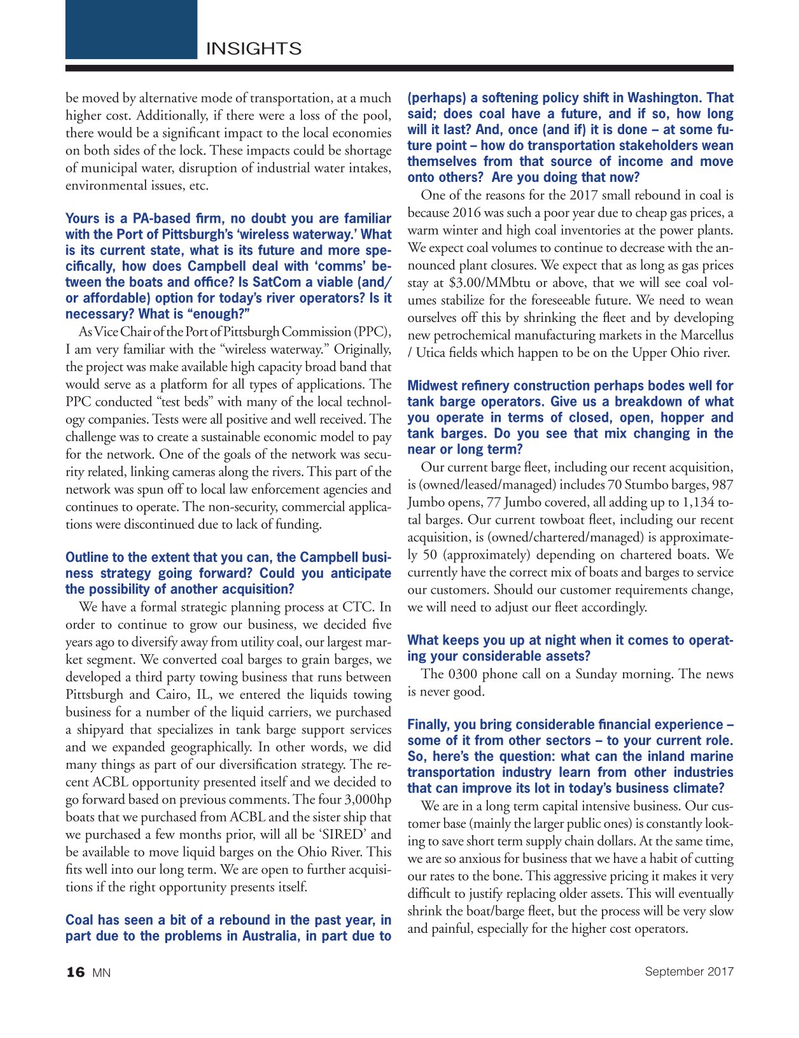
Page 16: of Marine News Magazine (September 2017)
Offshore Annual
Read this page in Pdf, Flash or Html5 edition of September 2017 Marine News Magazine
INSIGHTS be moved by alternative mode of transportation, at a much (perhaps) a softening policy shift in Washington. That said; does coal have a future, and if so, how long higher cost. Additionally, if there were a loss of the pool, will it last? And, once (and if) it is done – at some fu- there would be a signi? cant impact to the local economies ture point – how do transportation stakeholders wean on both sides of the lock. These impacts could be shortage themselves from that source of income and move of municipal water, disruption of industrial water intakes, onto others? Are you doing that now?
environmental issues, etc.
One of the reasons for the 2017 small rebound in coal is because 2016 was such a poor year due to cheap gas prices, a
Yours is a PA-based ? rm, no doubt you are familiar warm winter and high coal inventories at the power plants. with the Port of Pittsburgh’s ‘wireless waterway.’ What
We expect coal volumes to continue to decrease with the an- is its current state, what is its future and more spe- nounced plant closures. We expect that as long as gas prices ci? cally, how does Campbell deal with ‘comms’ be- tween the boats and of? ce? Is SatCom a viable (and/ stay at $3.00/MMbtu or above, that we will see coal vol- or affordable) option for today’s river operators? Is it umes stabilize for the foreseeable future. We need to wean necessary? What is “enough?” ourselves off this by shrinking the ? eet and by developing
As Vice Chair of the Port of Pittsburgh Commission (PPC), new petrochemical manufacturing markets in the Marcellus
I am very familiar with the “wireless waterway.” Originally, / Utica ? elds which happen to be on the Upper Ohio river.
the project was make available high capacity broad band that would serve as a platform for all types of applications. The
Midwest re? nery construction perhaps bodes well for
PPC conducted “test beds” with many of the local technol- tank barge operators. Give us a breakdown of what you operate in terms of closed, open, hopper and ogy companies. Tests were all positive and well received. The tank barges. Do you see that mix changing in the challenge was to create a sustainable economic model to pay near or long term?
for the network. One of the goals of the network was secu-
Our current barge ? eet, including our recent acquisition, rity related, linking cameras along the rivers. This part of the network was spun off to local law enforcement agencies and is (owned/leased/managed) includes 70 Stumbo barges, 987
Jumbo opens, 77 Jumbo covered, all adding up to 1,134 to- continues to operate. The non-security, commercial applica- tal barges. Our current towboat ? eet, including our recent tions were discontinued due to lack of funding.
acquisition, is (owned/chartered/managed) is approximate- ly 50 (approximately) depending on chartered boats. We
Outline to the extent that you can, the Campbell busi- currently have the correct mix of boats and barges to service ness strategy going forward? Could you anticipate the possibility of another acquisition?
our customers. Should our customer requirements change,
We have a formal strategic planning process at CTC. In we will need to adjust our ? eet accordingly.
order to continue to grow our business, we decided ? ve
What keeps you up at night when it comes to operat- years ago to diversify away from utility coal, our largest mar- ing your considerable assets?
ket segment. We converted coal barges to grain barges, we
The 0300 phone call on a Sunday morning. The news developed a third party towing business that runs between
Pittsburgh and Cairo, IL, we entered the liquids towing is never good.
business for a number of the liquid carriers, we purchased
Finally, you bring considerable ? nancial experience – a shipyard that specializes in tank barge support services some of it from other sectors – to your current role. and we expanded geographically. In other words, we did
So, here’s the question: what can the inland marine many things as part of our diversi? cation strategy. The re- transportation industry learn from other industries cent ACBL opportunity presented itself and we decided to that can improve its lot in today’s business climate?
go forward based on previous comments. The four 3,000hp
We are in a long term capital intensive business. Our cus- boats that we purchased from ACBL and the sister ship that tomer base (mainly the larger public ones) is constantly look- we purchased a few months prior, will all be ‘SIRED’ and ing to save short term supply chain dollars. At the same time, be available to move liquid barges on the Ohio River. This we are so anxious for business that we have a habit of cutting ? ts well into our long term. We are open to further acquisi- our rates to the bone. This aggressive pricing it makes it very tions if the right opportunity presents itself.
dif? cult to justify replacing older assets. This will eventually shrink the boat/barge ? eet, but the process will be very slow
Coal has seen a bit of a rebound in the past year, in and painful, especially for the higher cost operators.
part due to the problems in Australia, in part due to
September 2017
MN 16

 15
15

 17
17
